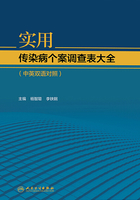
Section 14 Typhoid Fever and Paratyphoid Fever

Introduction of Typhoid Fever and Paratyphoid Fever
The pathogen for typhoid fever is Salmonella typhi,which belongs to the Salmonella group D. The pathogens for paratyphoid fever include S. paratyphi A,S. paratyphi B and S. paratyphi C,which belong to the Salmonella group A,B,C,respectively. The sources of the typhoid and paratyphoid infection are the patients and carriers,which are transmitted through contaminated water,food,flies and daily contact. Intake of contaminated water and food most often linked to outbreaks. Typhoid and paratyphoid are widespread,and is most common in rural. Individuals who have not had typhoid and not being vaccinated against typhoid are more susceptible to typhoid fever. Patients can acquire a stable immunity to typhoid after the onset of typhoid,and second infection is rare. There is no cross-immunity between typhoid and paratyphoid.
Typhoid fever and paratyphoid fever are perennial,but become rampant in summer and autumn,with mostly plaguing school-age children,followed by youth/adults and preschool children. There are age,gender and occupational differences incidences according to exposure chance. Since the advent of chloramphenicol in 1942,the mortality rate of typhoid has significantly decreased. However,the debut of drug-resistant strains in 1970s caused great difficulty in preventing and treating with typhoid.
Typhoid bacillus and A,B,C paratyphoid bacillus belong to Salmonella,containing bacterial“O” antigen and flagella “H” antigen,and some strains contain “Vi” antigen. Generally,typhoid onset slowly,may have fatigue,loss of appetite,general malaise,headache and back pain,and other prodromal symptoms. A few patients may have chill,fever,and sudden onset. Classically,the course of untreated typhoid fever may last 4-5 weeks,and is divided into four distinct stages of the early stage,climax stage,remitting state and recovery stage. In the early stage,the disease develops slowly,fever,and often accompanied by general malaise,loss of appetite,sour throat and cough. The body temperature rose in a ladder-like pattern,and reaching to 39-40℃within one week. The climax stage is characteristics by continued high fever,relatively slow pulse or heavy pulse,neurotoxic symptoms,rose-colored rash and splenomegaly. In the remitting stage,various complications including intestinal hemorrhage,intestinal perforation,bronchopneumonia and heart failure may occur. If there is no such complication,the patient’s temperature is decreased by the remittent fever pattern,and symptoms remit. In the recovery stage,body temperature become normal,the symptoms disappear and appetite recovery. Patients may become fully recovered within one month. In recent years,the clinical manifestations of typhoid are becoming mild and atypical. Diagnosis of typhoid can be based on the epidemiological,clinical and laboratory tests. For the criteria for diagnosis,please see the National Standards for Diagnosis of Typhoid and Paratyphoid.
伤寒、副伤寒流行病学个案调查表



Epidemiological Questionnaire for Cases of Typhoid Fever or Paratyphoid Fever

Questionnaire




(本节编者-汪慧 本节核对-范淑君)